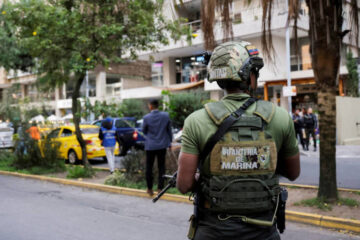Volcano erupts in southwest Iceland after weeks of earthquakes
 A volcano spews lava and smoke as it erupts in Grindavik, Iceland. (Photo: Reuters)
A volcano spews lava and smoke as it erupts in Grindavik, Iceland. (Photo: Reuters)
A volcano in Iceland was erupting on Tuesday, with geysers of molten lava shooting into the pitch-black night sky after weeks of seismic activity had the region southwest of the capital on high alert.
The eruption on the Reykjanes peninsula, just north of the fishing town Grindavik, began Monday at around 10:17 pm (22:17 GMT) after an earthquake swarm, the Icelandic Meteorological Office said, referring to a series of small shakes.
“A Coast Guard helicopter will take off shortly to confirm the exact location and size of the eruption,” the meteorological office said, adding it could be seen via nearby webcams.
Live-streamed footage of the eruption showed glowing orange jets of lava spewing from a gash in the ground, surrounded by billowing clouds of red smoke.
“We hope for the best but it is clear this is a considerable eruption,” Prime Minister Katrin Jakobsdottir wrote on Facebook.
For weeks, the Nordic country had been anticipating an eruption on the peninsula southwest of the capital after intense earthquake activity, which prompted authorities to evacuate thousands of people and close the Blue Lagoon geothermal spa famed for its turquoise waters.
The meteorological office estimated that the volcano had opened a fissure about 2.8 kilometres (1.7 miles) long, or three times greater than the most recent eruption over the summer.
“We now wait to see what the forces of nature have in store,” President Gudni Thorlacius Johannesson wrote on X, formerly Twitter. He added that protecting lives and infrastructure was the priority.
Public utility company Landsnet wrote on Facebook that it was very closely monitoring the eruption.
Despite fears prior to the eruption of the possible havoc it could cause global travel, Reykjavik’s international airport remains open. Operator ISAVIA said: “For the time being, no disruptions to arrivals or departures at Keflavik airport.”
– New era –
Since October, thousands of earthquakes have been detected on the Reykjanes peninsula, a possible precursor to an impending volcanic eruption.
Roughly 4,000 people were evacuated from Grindavik, a fishing port around 40 kilometres (25 miles) from Reykjavik, on November 11 after scientists determined that a tunnel of magma was shifting beneath them.
Residents told AFP the series of small earthquakes — sometimes hundreds per day — had damaged roads and buildings.
Since then, they have only been allowed to visit their homes during certain daylight hours.
Authorities have organised occasional trips into the village, escorting those with homes in the most perilous parts as they rescued everything from cherished pets to photo albums, furniture and clothing.
Volcanic eruptions are not uncommon in Iceland, which is home to 33 active volcano systems, the highest number in Europe. But the Reykjanes peninsula had not experienced an eruption for eight centuries until 2021.
Since then, three eruptions have struck, in 2021, 2022 and earlier this year — all in remote, uninhabited areas.
Volcanologists say this could be the start of a new era of activity in the region.
In 2010, the eruption of Iceland’s long-dormant Eyjafjallajokull volcano — an ice-capped volcano more than 1,660 metres tall — shot huge amounts of ash into the atmosphere. That explosive eruption was not fatal, but forced the cancellation of around 100,000 flights and left more than 10 million travellers stranded.
Situated in the North Atlantic, Iceland straddles the Mid-Atlantic Ridge, a crack in the ocean floor separating the Eurasian and North American tectonic plates.
AFP, TOE, AGENCIES











